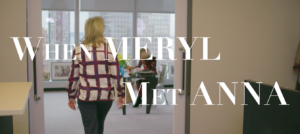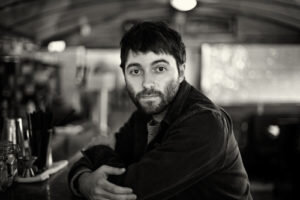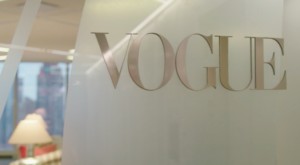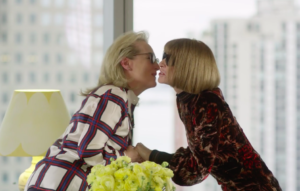Not Quite 73 Questions with Video Director-Producer Vincent Peone, Facilitator of the Funny
Vincent Peone is one of those people that Hollywood likes to call a "multi-hyphenate," someone whose jack-of-all-trades talents and I-can-do-it mindset when creating video and photography leads him to write, shoot, produce, direct and, well, whatever else is needed, on everything from high-end advertising to award-winning YouTube humor videos to an upcoming show on IFC, "Lee's Kill List."
 Add to that another title, "facilitator of the funny," as seen on work Peone has done as a producer-writer-director-videographer for Vogue, in support of its viral video series, "73 Questions," and much else. One notable recent piece featured Oscar winner (and Vogue cover model) Meryl Streep meeting with Vogue editor Anna Wintour. In that piece, the two powerhouses talk about Streep playing Wintour's friend and mentor, the late Washington Post publisher Katherine Graham, in the upcoming Steven Spielberg movie, "The Post," as well as "The Devil Wears Prada," where Streep played a Wintour-like character. Peone (pronounced "Pay-own") attended film school at New York’s School of Visual Arts, where he created 50 videos with his sketch group before becoming founder and staff director of the Originals department at CollegeHumor.com. He spent seven years at CollegeHumor, making thousands of videos as the site blossomed into one of YouTube’s largest content sources. Peone won a Webby Award for “The Sea is Blue,” the short film he created during YouTube’s annual Field Day.
Add to that another title, "facilitator of the funny," as seen on work Peone has done as a producer-writer-director-videographer for Vogue, in support of its viral video series, "73 Questions," and much else. One notable recent piece featured Oscar winner (and Vogue cover model) Meryl Streep meeting with Vogue editor Anna Wintour. In that piece, the two powerhouses talk about Streep playing Wintour's friend and mentor, the late Washington Post publisher Katherine Graham, in the upcoming Steven Spielberg movie, "The Post," as well as "The Devil Wears Prada," where Streep played a Wintour-like character. Peone (pronounced "Pay-own") attended film school at New York’s School of Visual Arts, where he created 50 videos with his sketch group before becoming founder and staff director of the Originals department at CollegeHumor.com. He spent seven years at CollegeHumor, making thousands of videos as the site blossomed into one of YouTube’s largest content sources. Peone won a Webby Award for “The Sea is Blue,” the short film he created during YouTube’s annual Field Day. Peone's TV work has drawn awards notice too, including two Emmy nominations for ABC’s “Boondoggle.” Other prominent work has included directing Viceland’s “Most Expensivist,” based on a Web series Peone created, and the Netflix show “The Green Beret’s Guide to Surviving the Apocalypse.”Vogue's "73 Questions" videos have been a hit, each built around a single several-minute take where a celebrity is peppered with questions about their life and opinions while simultaneously giving a home tour. We caught up with Peone recently to talk Meryl and Anna, making funny videos with funny people and much more. We didn't make it to 73 questions, but Peone answered several good ones, which are highlighted here. If you'd like to hear the whole conversation, listen to my podcast, Bloom In Tech, here. TVR: There’s a lot of humor in some of these Vogue shorts, such as the ones with Mindy Kaling and a "Zoolander 2" piece featuring Ben Stiller and Owen Wilson at an actual Paris fashion show. You have a long background in creating funny video, but these are all prodigiously funny people in their own right. Who’s driving the creation and direction of these projects, and how do the shorts come into being?VP: Fine question. I think people come to me because I do comedy, so a lot of the stuff that comes across my desk is inherently funny, or at least on its way there. Vogue is an interesting client, because they're sort of now more than ever dipping their toes into comedy. They're unquestionably the authorities of their own universe. With comedy, they hand quite a bit of trust to me and I suppose to anybody else who's working with them. It's kind of a cool gig to get in front of people like Ben Stiller and Owen Wilson and just be given the keys to drive a project that's really important to them and they trust your instincts implicitly. It's been a really cool partnership. TVR: So how does it work with a star like Mindy Kaling or Ben and Owen? Does it ping pong back and forth between you and them?VP: Well, you know people like Mindy and Ben are such consummate professionals so they come prepared. They had a few ideas and things, a checklist. Mindy's was a little looser. Ben came with a specific script he'd been working on. Jon Daly was one of the writers. Funnily enough, we used to work together on CollegeHumor.com videos back in the day, so that was a weirdly rounded-out connection that we didn't realize until the day. In some cases, I'm not going to lie, I'm there to facilitate the funny and strengthen it and support it and nourish it. Other times, like the Mindy script, we didn't really have a script. There was a lot more ironing of things out and feeling it out. Her being who she is, it was just a matter of playing around with things and seeing what worked the best. TVR: You’ve produced and shot plenty of other 73 Questions videos, with stars such as Selena Gomez, Nicole Kidman, Daisy Ridley and Neil Patrick Harris. These are filmed without a cut or break over several long minutes of rapid-fire questions as you roam about their home. What’s that process like? How much set-up time is required? How many takes does it usually require to get one of these in the can?VP: It's funny. When the show first came to be, the first (episode) we did was with Sarah Jesica Parker, and I would joke that she ought to get a producer credit on it because she helped us create the show. (Co-creator Joe Sabia of Conde Nast's digital unit) said, 'I want to give Sarah Jessica Parker a personality test like she's never done it before,' and I said, 'Why don't we try walking through her house without ever cutting?' So was born the creation of this weird interview series. We showed up at her door with 100 questions, and 73 was exactly how long it took to get around the ground floor of her brownstone. That was the way we picked the number for the show.
Peone's TV work has drawn awards notice too, including two Emmy nominations for ABC’s “Boondoggle.” Other prominent work has included directing Viceland’s “Most Expensivist,” based on a Web series Peone created, and the Netflix show “The Green Beret’s Guide to Surviving the Apocalypse.”Vogue's "73 Questions" videos have been a hit, each built around a single several-minute take where a celebrity is peppered with questions about their life and opinions while simultaneously giving a home tour. We caught up with Peone recently to talk Meryl and Anna, making funny videos with funny people and much more. We didn't make it to 73 questions, but Peone answered several good ones, which are highlighted here. If you'd like to hear the whole conversation, listen to my podcast, Bloom In Tech, here. TVR: There’s a lot of humor in some of these Vogue shorts, such as the ones with Mindy Kaling and a "Zoolander 2" piece featuring Ben Stiller and Owen Wilson at an actual Paris fashion show. You have a long background in creating funny video, but these are all prodigiously funny people in their own right. Who’s driving the creation and direction of these projects, and how do the shorts come into being?VP: Fine question. I think people come to me because I do comedy, so a lot of the stuff that comes across my desk is inherently funny, or at least on its way there. Vogue is an interesting client, because they're sort of now more than ever dipping their toes into comedy. They're unquestionably the authorities of their own universe. With comedy, they hand quite a bit of trust to me and I suppose to anybody else who's working with them. It's kind of a cool gig to get in front of people like Ben Stiller and Owen Wilson and just be given the keys to drive a project that's really important to them and they trust your instincts implicitly. It's been a really cool partnership. TVR: So how does it work with a star like Mindy Kaling or Ben and Owen? Does it ping pong back and forth between you and them?VP: Well, you know people like Mindy and Ben are such consummate professionals so they come prepared. They had a few ideas and things, a checklist. Mindy's was a little looser. Ben came with a specific script he'd been working on. Jon Daly was one of the writers. Funnily enough, we used to work together on CollegeHumor.com videos back in the day, so that was a weirdly rounded-out connection that we didn't realize until the day. In some cases, I'm not going to lie, I'm there to facilitate the funny and strengthen it and support it and nourish it. Other times, like the Mindy script, we didn't really have a script. There was a lot more ironing of things out and feeling it out. Her being who she is, it was just a matter of playing around with things and seeing what worked the best. TVR: You’ve produced and shot plenty of other 73 Questions videos, with stars such as Selena Gomez, Nicole Kidman, Daisy Ridley and Neil Patrick Harris. These are filmed without a cut or break over several long minutes of rapid-fire questions as you roam about their home. What’s that process like? How much set-up time is required? How many takes does it usually require to get one of these in the can?VP: It's funny. When the show first came to be, the first (episode) we did was with Sarah Jesica Parker, and I would joke that she ought to get a producer credit on it because she helped us create the show. (Co-creator Joe Sabia of Conde Nast's digital unit) said, 'I want to give Sarah Jessica Parker a personality test like she's never done it before,' and I said, 'Why don't we try walking through her house without ever cutting?' So was born the creation of this weird interview series. We showed up at her door with 100 questions, and 73 was exactly how long it took to get around the ground floor of her brownstone. That was the way we picked the number for the show.  TVR: The recent segment you did with Vogue editor Anna Wintour and Meryl Streep is terrific. It’s also very different. For one thing, Anna is interviewing Meryl, instead of you or another colleague behind the camera. For another, it’s at Vogue, in Anna’s offices, and you include a couple of witty bits that refer to Streep’s performance in “The Devil Wears Prada,” where her character is based on Wintour’s own larger-than-life personality. It’s also a three-camera shoot with lots of cuts and a whole setup before the two of them settle in to their conversation. What was the creative process like on the project? VP: We decided early on that we had to address "The Devil Wears Prada," even though the reference is fairly old by this point. But they haven't really had too much interaction, at least publicly. We decided if we're going to get these two titans of the universe together, we had to at least speak to why it's such a crazy thing that they're sitting across from each other. We came up with this cool idea to introduce Meryl in a way that pays homage to one of the more famous scenes in "The Devil Wears Prada." We thought it would be a good way to open it up and frankly, it was the best use of our time with Meryl, because if you look, it feels like she's present a lot more in that intro than she really is. She's only present in two shots. We built the mythology of who she is around those two shots, and had a little fun with the visual storytelling. From that point on, they sat down to the interview and we knew that part would be good because they're both such juggernauts that they would be interesting, and we were not disappointed. The topics ranged from Harvey Weinstein to being a mom to what they sat down to talk about, which is that Meryl is playing Katherine Graham in Spielberg's movie. TVR: I love the part where Wintour talks about being intimidated by Katherine Graham, the publisher of the Washington Post during the Watergate scandal and later Winter’s mentor and friend. Streep is playing Graham in an upcoming Spielberg movie about the Post during that era. So, were you at all intimidated shooting this particular project?
TVR: The recent segment you did with Vogue editor Anna Wintour and Meryl Streep is terrific. It’s also very different. For one thing, Anna is interviewing Meryl, instead of you or another colleague behind the camera. For another, it’s at Vogue, in Anna’s offices, and you include a couple of witty bits that refer to Streep’s performance in “The Devil Wears Prada,” where her character is based on Wintour’s own larger-than-life personality. It’s also a three-camera shoot with lots of cuts and a whole setup before the two of them settle in to their conversation. What was the creative process like on the project? VP: We decided early on that we had to address "The Devil Wears Prada," even though the reference is fairly old by this point. But they haven't really had too much interaction, at least publicly. We decided if we're going to get these two titans of the universe together, we had to at least speak to why it's such a crazy thing that they're sitting across from each other. We came up with this cool idea to introduce Meryl in a way that pays homage to one of the more famous scenes in "The Devil Wears Prada." We thought it would be a good way to open it up and frankly, it was the best use of our time with Meryl, because if you look, it feels like she's present a lot more in that intro than she really is. She's only present in two shots. We built the mythology of who she is around those two shots, and had a little fun with the visual storytelling. From that point on, they sat down to the interview and we knew that part would be good because they're both such juggernauts that they would be interesting, and we were not disappointed. The topics ranged from Harvey Weinstein to being a mom to what they sat down to talk about, which is that Meryl is playing Katherine Graham in Spielberg's movie. TVR: I love the part where Wintour talks about being intimidated by Katherine Graham, the publisher of the Washington Post during the Watergate scandal and later Winter’s mentor and friend. Streep is playing Graham in an upcoming Spielberg movie about the Post during that era. So, were you at all intimidated shooting this particular project?  VP: Definitely. I joke that I'm not usually someone who cares what I wear to work, but I changed my clothes 15 times that morning before going in. What do you wear going into that interview? But they made it easy, because they're so professional. We had some good planning and some good insight about how the day was going to run, and I attribute that to the production team over at Vogue. That was super helpful. Yeah, this was different. I'd look left and then right and literally pinch myself, because I'm standing right between two of the most powerful, amazing women, brilliantly talented women in their own respective fields, telling them "Give me another take." It was quite an experience. It's not something I expect to have happen again anytime soon. TVR: Their conversation covered a lot of ground. Did any of that resonate for you?VP: Yeah, I found myself listening quite a bit, just sitting back and hearing what they had to say, because I was just as interested as anyone listening back at home. And then it became my time to direct again as soon as they stopped talking. We live in insane times and to see these two women who have such influence, and to see them frustrated by it all, it really humanized them. As Meryl said, it's an amazing, eye-opening time in our history, and all we can hope for is to keep going forward and not go backwards.Again, to hear all the questions we asked Vincent Peone about his work, his favorite gear, the future of video and VR and much else, go to my Bloom in Tech podcast, where we ranged even further afield, talking about Peone's favorite gear, the future of advertising, using augmented- and virtual-reality tools and much else.You can see more of Vincent Peone’s work at his website, VincePeone.com and follow him on Twitter, Instagram and Snapchat at his name, Vincent Peone. Vincent’s management team is Principato Young Entertainment and his commercial representation in the United States is with Caroline Gomez at Big Block Media.
VP: Definitely. I joke that I'm not usually someone who cares what I wear to work, but I changed my clothes 15 times that morning before going in. What do you wear going into that interview? But they made it easy, because they're so professional. We had some good planning and some good insight about how the day was going to run, and I attribute that to the production team over at Vogue. That was super helpful. Yeah, this was different. I'd look left and then right and literally pinch myself, because I'm standing right between two of the most powerful, amazing women, brilliantly talented women in their own respective fields, telling them "Give me another take." It was quite an experience. It's not something I expect to have happen again anytime soon. TVR: Their conversation covered a lot of ground. Did any of that resonate for you?VP: Yeah, I found myself listening quite a bit, just sitting back and hearing what they had to say, because I was just as interested as anyone listening back at home. And then it became my time to direct again as soon as they stopped talking. We live in insane times and to see these two women who have such influence, and to see them frustrated by it all, it really humanized them. As Meryl said, it's an amazing, eye-opening time in our history, and all we can hope for is to keep going forward and not go backwards.Again, to hear all the questions we asked Vincent Peone about his work, his favorite gear, the future of video and VR and much else, go to my Bloom in Tech podcast, where we ranged even further afield, talking about Peone's favorite gear, the future of advertising, using augmented- and virtual-reality tools and much else.You can see more of Vincent Peone’s work at his website, VincePeone.com and follow him on Twitter, Instagram and Snapchat at his name, Vincent Peone. Vincent’s management team is Principato Young Entertainment and his commercial representation in the United States is with Caroline Gomez at Big Block Media.

